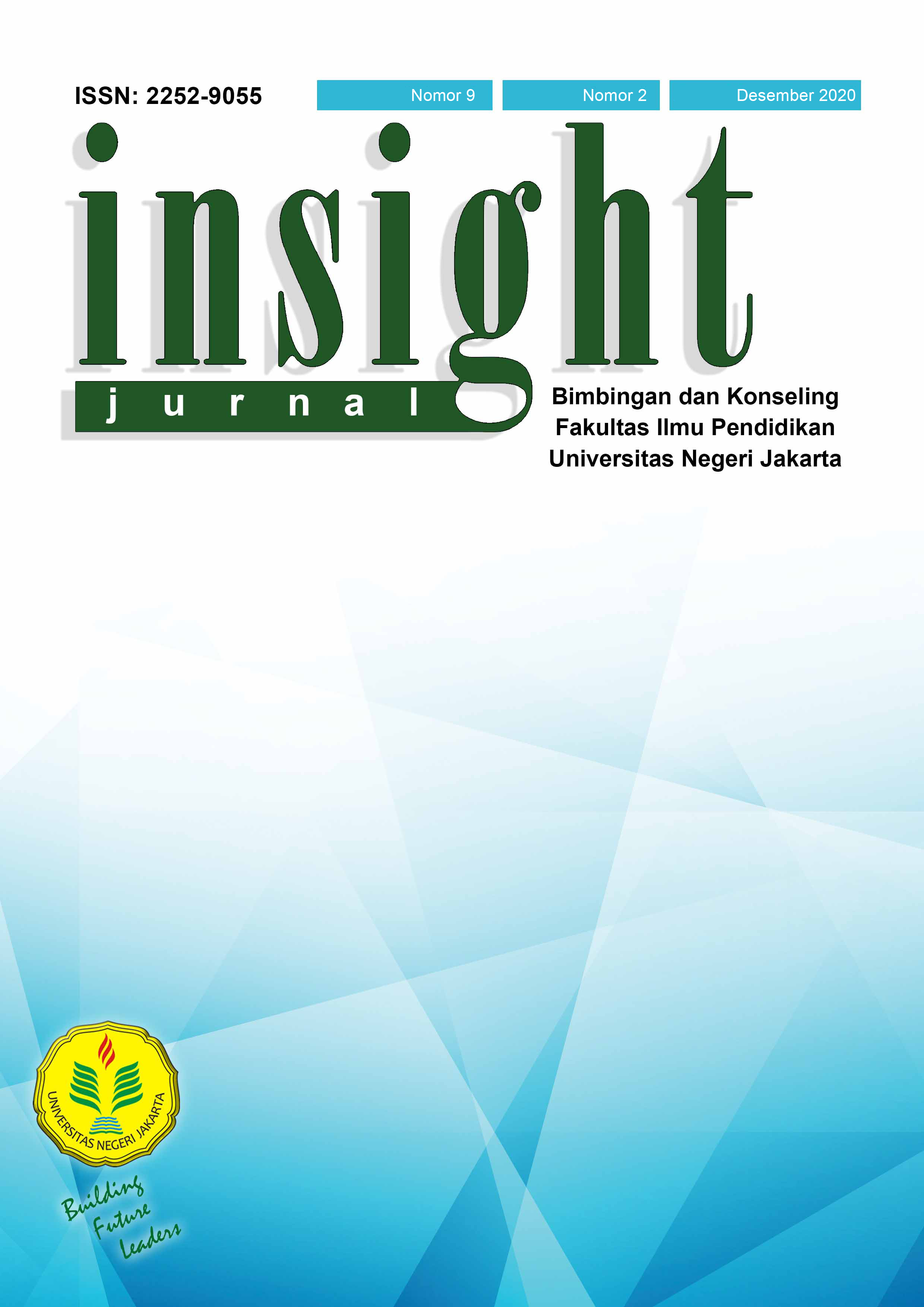Pengembangan Self-help Book Dengan Program Making Friends With Yourself untuk Meningkatkan Self-compassion Peserta Didik Kelas X SMA Negeri 38 Jakarta
DOI:
https://doi.org/10.21009/INSIGHT.092.03Keywords:
Self-help book, self-compassionAbstract
Penelitian ini dilakukan untuk mengembangkan self-help book dengan program making friends with yourself untuk meningkatkan self-compassion peserta didik kelas X SMA Negeri 38 Jakarta. Metode penelitian yang digunakan dalam penelitian ini adalah DBR yang merupakan akronim dari Design Based Research atau biasa disebut Educational Design Research yang terdiri dari tiga tahapan inti yakni (1) Analisis dan Eksplorasi, (2) Desain dan Konstruk, (3) Evaluasi dan Refleksi. Penelitian ini hanya dilakukan sampai tahap evaluasi. Penelitian dilakukan di SMA Negeri 38 Jakarta. Subjek penelitian ini adalah 154 peserta didik kelas X SMA Negeri 38 Jakarta. Dalam mengumpulkan data, peneliti menggunakan teknik penyebaran angket dan wawancara pada peserta didik. Hasil uji validasi dengan ahli media, skor yang didapatkan sebesar 77,27% (layak) dengan keunggulan memiliki desain yang menarik, pemilihan ukuran dan bentuk yang tepat, serta tujuan materi dapat tersampaikan. Sedangkan hasil uji validasi dengan ahli materi mendapatkan skor sebesar 91,25% (sangat layak) yang artinya self-help book yang dikembangkan telah sesuai dengan program making friends with yourself. Pengembangan self-help book memberikan informasi mengenai self-compassion, serta keterampilan dalam mengembangkan self-compassion.
Kata Kunci: Self-Help Book, Self-Compassion.
References
Arikunto, S., 2006. Prosedur Penelitian. Yogyakarta: Rineka Cipta.
Azwar, S., 2012. Metode Penelitian. Yogyakarta: Pustaka Pelajar.
Dahotre, A. Z. Y. a. S. C 2010. A qualitative study of animation programming in the wild. Proceedings of the 2010 ACM-IEEE International Symposium on Empirical Software Engineering and Measurement.
Grzybowska, K. a. Ł. A., 2017. Key competencies for Industry 4.0. Economics & Management Innovations, vol. 1, no. 1, pp. 250-253.
Herman, T 2019. Capability of mathematical strategic thinking through quantum learning based on creative problem solving. Journal of Physics: Conference Series, vol. 1320, no. 1, p. 012099.
Kadir, A., 2015. Buku Pintar Pemrograman Arduino: Tutorial Mudah dan Praktis Membuat Perangkat Elektronik Berbasis Arduino. Yogyakarta: Andi .
Kadir, A., 2016. Scratch for Arduino Panduan untuk Mempelajari Elektronika dan Pemrograman. Yogyakarta: Andi.
Kalelioglu, F. a. G. Y., 2014. The Effects of Teaching Programming via Scratch on Problem Solving Skills: A Discussion from Learners Perspective. Informatics in Education, vol. 13, no. 1, pp. 33-50.
Kordaki, M., 2012. Diverse Categories of Programming Learning Activities could be Performed within Scratch. Procedia-Social and Behaviour Scirnces, vol. 46, pp. 1162-1166.
Levy, A. (2012). STRATEGIC THINKING AS A LEARNING PROCESS. Revista Científica" Visión de Futuro, vol. 16, no. 1.
Larson, R., & Hansen, D 2005. The development of strategic thinking: Learning to impact human systems in a youth activism program. Human Development, vol. 48, no. 6, pp. 327-349.
Malik, A. V. a. C. M. M., 2018. Improving Students' Critical-Thinking Skills Through Student Facilitator and Explaining Modelin Momentum and Impulse Topic. Jurnal Penelitian dan Pengembangan Pendidikan Fisika, vol. 4, no. 2, pp. 55-64.
Ortiz-Colón, A. d. M. R. J., 2016. Teaching with Scratch in Compulsory Secondary Education. iJET, vol. 11, no. 2, pp. 60-67.
Papadakis, S. K. M. O. V. a. Z. N., 2014. Novice programming environments. Scratch & app inventor: A first comparison.. Proceedings of the 2014 workshop on interaction design in educational environments , p. 1.
Pratiwi, U. d. F. E., 2015. Pengembangan Instrumen Penilaian HOTS Berbasis Kurikulum 2013 Terhadap Sikap Disiplin. Jurnal Penelitian dan Pembelajaran IPA, vol. 1, no. 1, pp. 123-142.
Pratiwi, U. S. d. A. R., 2018. Student Computational Logical Thinking of Block Programming Concept in Arduino Learning By S4A (Scratch for Arduino). ASSEHR AECON, vol 267, pp. 245-248.
Resnick, d., 2009. Scratch: Programming for all communications of the acm,. communications of the acm, vol. 52, no. 11, pp. 60-67.
Rohida, L., 2018. Pengaruh Era Revolusi Industri 4.0 terhadap Kompetensi Sumber Daya Manusia. Jurnal Manajemen Bisnis Indonesia, vol. 6, no. 1, pp. 114-136.
Saftari, F., 2015. Proyek Robotik Keren dengan Arduino: Panduan Lengkap Memulai Proyek Robotik yang mearik.. Jakarta: Gramedia.
Sanders, T. I., & Sanders, J. R. (1998). Strategic thinking and the new science: planning in the midst of chaos complexity and change. Simon and Schuster.
Sieg, W. (2007). The AProS project: Strategic thinking & computational logic. Logic Journal of the IGPL, vol. 15, no. 4, pp. 359-368.
Serevina, V., Nasbey, H., & Andriana, W. (2017). The Development of a learning material using the scratch programming language to helping student leaning momentum and impulse subject in senior high school. In Proceedings of international Conference on Technology and Sosial Science.
Vega, J., Murari, A., Dormido-Canto, S., Moreno, R., Pereira, A., Acero, A., & JET-EFDA Contributors. (2014). Adaptive high learning rate probabilistic disruption predictors from scratch for the next generation of tokamaks. Nuclear Fusion, vol. 54, no. 12.
Downloads
Published
Issue
Section
License
Authors who publish with this Journal agree to the following terms:
- Author retain copyright and grant the journal right of first publication with the work simultaneously licensed under a creative commons attribution licensethat allow others to share the work within an acknowledgement of the work’s authorship and initial publication of this journal.
- Authors are able to enter into separate, additional contractual arrangementfor the non-exclusive distribution of the journal’s published version of the work (e.g. acknowledgement of its initial publication in this journal).
- Authors are permitted and encouraged to post their work online(e.g. in institutional repositories or on their websites) prior to and during the submission process, as it can lead to productive exchanges, as well as earlier and greater citation of published works.
Users/public use of this website will be licensed to CC BY







